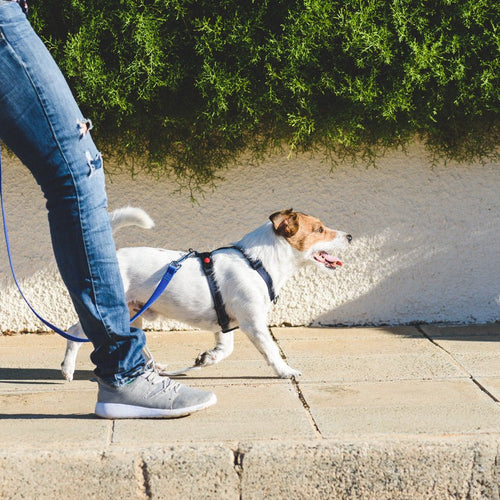How Much Exercise Does Your Dog Actually Need?

Are you researching dog breeds to make an informed decision about their daily exercise needs? Maybe you're wondering if the senior dog snoring next to you on the couch would benefit from a little more activity, or if your new puppy is getting too much. There's no "one size fits all" exercise routine for dogs, as their needs vary between breeds and change as they age.
Here's what you need to know about your dog's ideal amount of exercise, and how you can vary their activities to keep them healthy and happy.
Different exercise needs for different dog breeds
A Siberian husky certainly needs more physical exercise than a chihuahua, and task-driven herding dogs like border collies might need more mental stimulation and vigorous playtime in their activities than do other breeds in their group, such as corgis. Here are a few breed types and their requirements to help you get started with your research!
Sighthounds
Greyhounds, Salukis, and whippets are bred for speed rather than endurance and enjoy short bursts of sprinting mixed in with 2-3 walks throughout the day. Expect to exercise your greyhound or whippet for about 60-90 minutes daily.
Retrievers
Goldens, labs, and other retriever breeds need vigorous activity 2-3 times a day for about 20-30 minutes each session. Get those tennis balls ready!
Short-muzzled dogs
Many brachycephalic breeds—those with short snouts and broad faces—are better off with less vigorous exercise than most other dogs. Most English bulldogs, for example, have both breathing and joint issues, and require moderately-paced walks about twice each day, and overall daily exercise totaling no more than 30-45 minutes. French bulldogs and pugs might be higher-energy and can take about 60 minutes of exercise in 3-4 sessions.
Giant breeds
Most very large dogs do best with low-impact exercises such as long walks and swimming, with some good backyard "zoomies" to burn off energy. Most giant breeds like Great Danes, Great Pyrenees, and Bernese Mountain Dogs can be a bit lazy, so they won't let you know when they need more exercise than they're getting. Shoot for about 30-45 minutes of walking time each day, and give them plenty of room in your backyard to explore.
Hounds
These hunting dogs are bred to cover a lot of ground, and they appreciate 60-90 minutes of brisk walking each day. Beagles are particularly energetic, and as notorious escape artists, if they're not given enough exercise, they'll get their own!
Terriers
These high-energy dogs need as much mental stimulation as they do exercise. Give them about an hour of exercise a day, with plenty of free time to roam and explore their backyards. Terriers love problem-solving, so hiding toys for them to find, giving them treat-loaded puzzle toys, and playing hide-and-seek with them are great ways to keep them happy.
Toy breeds
Tiny dogs like chihuahuas, toy poodles, and Japanese Chins have a lot of energy, but they can tire out easily trying to keep up on long walks. Pet owners should engage in a lot of playtime with their toy breeds, in addition to short but energetic daily walks. Give them about 2-3 short walks a day—about 10-15 minutes each—with a lot of short play periods added to the mix.
Age influences exercise requirements
How much regular exercise your dog needs depends not only on its breed and individual personality but its age. As a general rule, puppies should get about five minutes of exercise for each month of age, twice a day, slowly increasing intensity and time as they approach their first year. This allows their joints to fully develop without injury and gives them enough time to rest and recuperate. A mobility harness may also be helpful for aging dogs or dogs who are post surgery and need a little help with their exercise.
Giant breed pups mature more slowly than most dogs, and toy breeds mature more quickly, so your vet might tailor physical activity plans specific to your pet. Older dogs require lower-intensity activities as they age. Just as with dog owners, their joints get stiff and they're more easily injured. Adult dogs that get appropriate amounts of regular exercise tend to develop better bone density, which will help them as they age.
Mix it up! Activities to keep your dog healthy
What types of exercise are best for your pooch? Depending on their energy levels, activities that keep your adult dog's mind engaged, and their bodies fit include flyball, agility, tracking, and trips to the dog park. Obedience training and rally classes are wonderful ways to make new friends among other pet parents and help your pet be a good dog when at home or out and about. Varied dog exercise doesn't just help with their well-being; it strengthens the bond between you and your pet.
Sometimes our schedules prevent us from giving our dogs the daily exercise they need. Dog daycare is a great way to give active dogs the stimulation and socialization they need when we're at work!
When in doubt, check with your vet
Before you begin a new exercise routine, consider taking your dog in for a physical. After assessing your dog's overall health, your vet can help you develop a diet and exercise plan that's tailored to your pet. Be prepared to answer questions about your dog's current schedule, and whether they're exhibiting behavioral changes.
Reward your pet after playtime
Just like us, dogs love to recover and relax after a workout. Give them healthy treats, provide them with comfortable bedding, and if they want a more private retreat in your home, let them have it. Dogs need alone time, too, and you can prevent separation anxiety in puppies and adult dogs by giving them their space when they're inclined to rest.
Let us know if you need help pampering your pet!
FAQ
What happens if dogs don't get enough exercise?
Sedentary dogs can suffer from obesity, which can cause damage to your pet's organs. Boredom and pent-up energy is a leading cause of destructive behavior.
Does walking count as exercise for dogs?
Absolutely! The intensity of exercise dog walks provide depends on the dog's age, condition, breed, and the speed at which you (and your dog) walk.
What should I do if I think my dog isn't getting enough exercise?
Make a trip to your veterinarian, and have them give your dog a physical to determine your dog's condition and help you put together an exercise and diet plan for your dog.
Subscribe
Sign up to get the latest on sales, new releases and more…
Categories
- 5 Easy Organic Christmas Recipes for Dogs: Simple Holiday Treats Your Companion Will Love
- The 6 Best Luxury Gifts for Your Dog This Christmas: Thoughtful Holiday Comfort That Truly Lasts
- Why Playtime Matters: The Benefits of Mental Stimulation and Playtime with Your Companion
- Tails of Celebration: The Miao Dog-Carrying Festival - A Hero's Honor in China
- A Dog-Friendly Thanksgiving 2025: Comfort, Calm, and Easy Treat Recipes
- The Best Dog Beds for Winter 2025: 5 Luxury Styles for Warmth, Comfort & Orthopedic Support
- Tails of Celebration: The Feast of Saint Hubert — Belgium's Timeless Blessing
- Halloween Safety Tips for Dogs: How to Keep Your Companion Safe This Spooky season
- Tails of Celebration: Día de los Muertos / Day of the Dead for Pets, A Festival of Memory in Mexico
- How to Care for Senior Dogs in Fall: Mobility Tips & Joint Support
- Tails of Celebration: Kukur Tihar & The Tihar Festival of Nepal
- What is a VDI Testing for dogs ? : Insights, Procedures and Preventive Measures
- Cheap Dog Beds vs. Luxury Dog Beds: The Real Cost of a $50 "Disposable" Dog Bed
- Can Dogs Have OCD? Understanding Canine Compulsive Behaviors (CCD)
- Does My Dog Like Music? Find Out What Tunes Make Your Pup Wag!
- Effective Solutions for Food Aggression in Dogs
- 7 Frozen Treats Your Dog Will Love This Summer☀️🧊🍉
- The Best Waterproof Liners for Dog Beds: Protect Against Spills, Drool, and Accidents
- How to Cope with the Loss of a Dog: A Tribute to Every Companion We Carry in Our Hearts
- Top Tips on How to Prevent Matting in Dogs
- Understanding and Managing Dogs with Hip Dysplasia
- The Ultimate Guide to Dog Gut Health: Natural Remedies, Probiotic Insights and Signs of Poor Gut Health
- The Best Supplements for Dogs: Explore Top Picks for Canine Health and Wellness
- How Often Should I Brush My Dog's Teeth? Tips for Optimal Canine Dental Health
- Ultimate Guide on How to Comfort Your Dog During Fireworks this 4th of July
- Managing a Blowing Coat: Essential Grooming Tips for Double-Coated Dogs.
- 5 Daily Habits That Boost Your Dog’s Long-Term Wellness
- Mastering Crate Training a Dog: Tips and Benefits
- Dog Car Seats vs. Seat Covers: What’s The Best Option For Your Companion?
- Best Outdoor Dog Beds: Luxury, Durability, and Unmatched Comfort
- Is My Dog Overweight? Tips to Assess and Help Your Companion
- The Best Faux Fur Dog Beds for Ultimate Pet Comfort of 2025
- Dog Running Guide: How to Start, Train & Stay Safe when running with your Dog
- Indestructible Dog Beds? The Truth Behind the Term
- Top Tips for Effective Exercise for Dogs
- Effective Dog Ear Cleaning: A Step-by-Step Guide for Maintaining Healthy Ears
- How to Manage Dog Aggressive Behaviors: Expert Tips and Advice
- Effective Canine Ear Infection Remedies: Symptoms, Causes & Treatments
- How to Make a New Dog Comfortable in Their New Home - 2025 Guide
- Signs of Dog Allergy Symptoms and How to Help and Prevent Them
- Why Does My Dog Lick Their Paws? Causes and Solutions Explained
- Dog Alzheimer's: Symptoms, Causes, and Treatment Options
- The Legacy of Comfort with the Iconic Animals Matter® Ortho Companion-Pedic® Puff Luxury Dog Bed
- Orthopedic Square Dog Beds: The Ultimate Blend of Luxury, Comfort, and Support
- Loungers: The Ultimate Beds for Luxury, Comfort, and Orthopedic Support
- Square Dog Beds: Orthopedic Comfort and Stylish Designs for Your Companion
- Effective Solutions for Canine Incontinence: Identifying Causes and Best Treatments
- Ethical, Sustainable, and Certified: Why Certified Products Matter, Exploring CA Prop 65 and CertiPUR-US® Standards
- Dog Seizures: Signs, Causes, and How to Help Dogs with Seizures
- Celebrate National Dog Day: Here are ideas for Dog Lovers and a dive into the history of our canine companions.


Leave a comment
Please note, comments must be approved before they are published